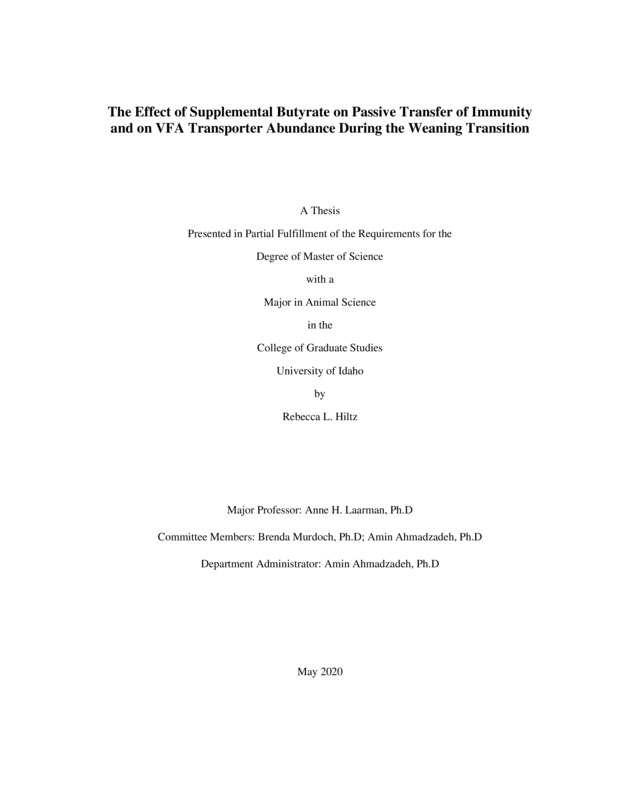The Effect of Supplemental Butyrate on Passive Transfer of Immunity and on VFA Transporter Abundance During the Weaning Transition
Hiltz, Rebecca. (2020-01). The Effect of Supplemental Butyrate on Passive Transfer of Immunity and on VFA Transporter Abundance During the Weaning Transition. Theses and Dissertations Collection, University of Idaho Library Digital Collections. https://www.lib.uidaho.edu/digital/etd/items/hiltz_idaho_0089n_11692.html
- Title:
- The Effect of Supplemental Butyrate on Passive Transfer of Immunity and on VFA Transporter Abundance During the Weaning Transition
- Author:
- Hiltz, Rebecca
- ORCID:
- 0000-0001-6071-1558
- Date:
- 2020-01
- Keywords:
- butyrate calf starter immunoglobulins passive transfer weaning
- Program:
- Animal and Veterinary Science
- Subject Category:
- Animal sciences; Agriculture; Biology
- Abstract:
-
The acquisition of passive transfer of immunity and weaning transition are two events in early calfhood that are critical to calf health and growth. Without adequate passive transfer calves are more susceptible to disease for the first 6-8 weeks of life and without a successful weaning transition calves may experience weight loss and nutritional stress. Dietary inclusion of sodium butyrate may improve both passive transfer and the weaning transition. In experiment 1, twenty neonatal calves were assigned to either control (CTRL-C) or sodium butyrate supplementation (BUT-C). Butyrate supplementation reduced IgG absorption in BUT-C calves but did not affect average daily gain. It is not recommended to supplement calves with butyrate before the cessation of intestinal immunoglobulin absorption. In experiment 2, thirty-six Holstein bull calves were assigned to milk-only (PRE-M), calf starter and hay (PRE-S), calf starter and hay with a two-week weaning transition (POST-S), or calf starter and hay with a two-week weaning transition plus supplemental sodium butyrate (POST-B). Calves were harvested and rumen epithelial tissue was examined for VFA transporter abundance (MCT1) plus transporters involved in intracellular pH regulation (NHE3 and NBC1). MCT1 abundance was not affected by the addition of solid feed to the diet, weaning, or butyrate supplementation. NBC1 abundance increased with the dietary inclusion of solid feed, suggesting the developing rumen has the capacity to adapt to dietary changes. NHE3 abundance decreased during weaning, suggesting that the rumen epithelium acidifies itself through the weaning transition, though the physiological relevance of this phenomenon is unknown.
- Description:
- masters, M.S., Animal and Veterinary Science -- University of Idaho - College of Graduate Studies, 2020-01
- Major Professor:
- Laarman, Anne
- Committee:
- Ahmadzadeh, Amin ; Murdoch, Brenda
- Defense Date:
- 2020-01
- Identifier:
- Hiltz_idaho_0089N_11692
- Type:
- Text
- Format Original:
- Format:
- application/pdf
- Rights:
- In Copyright - Educational Use Permitted. For more information, please contact University of Idaho Library Special Collections and Archives Department at libspec@uidaho.edu.
- Standardized Rights:
- http://rightsstatements.org/vocab/InC-EDU/1.0/

